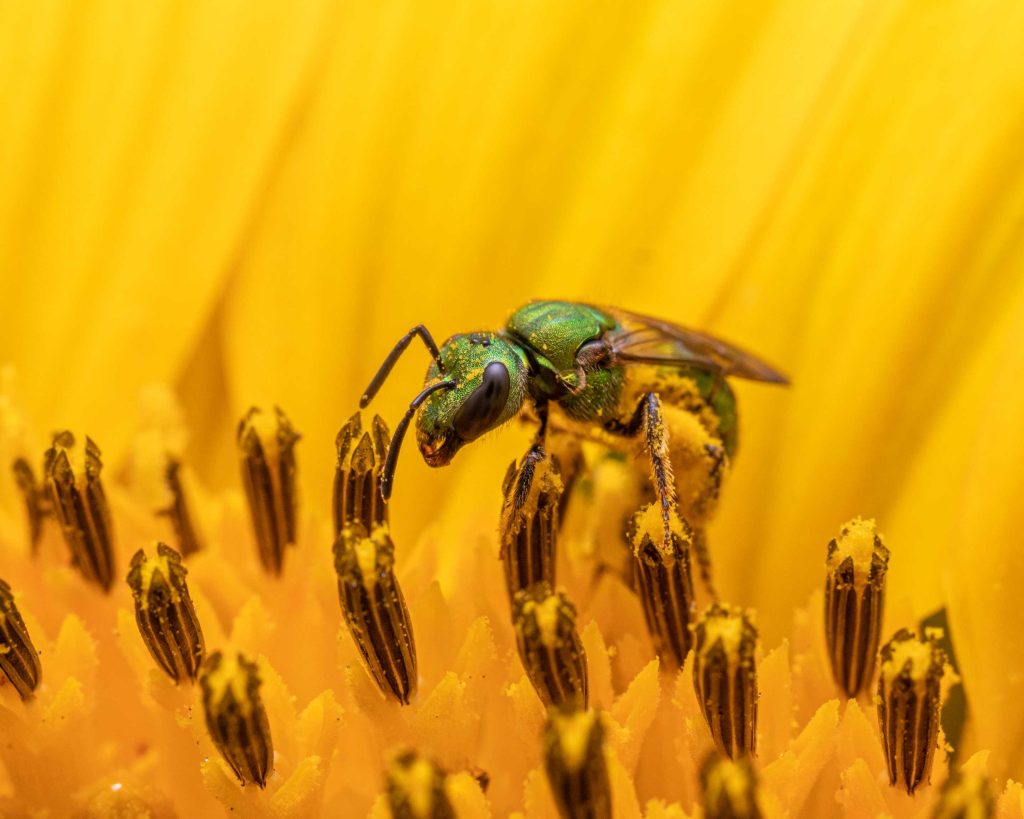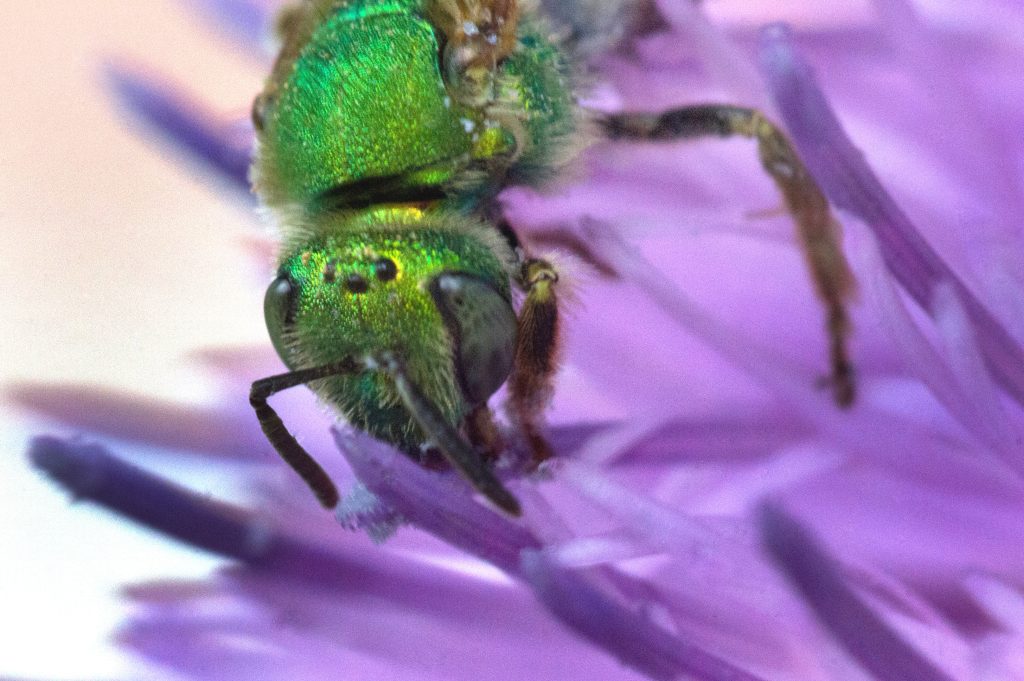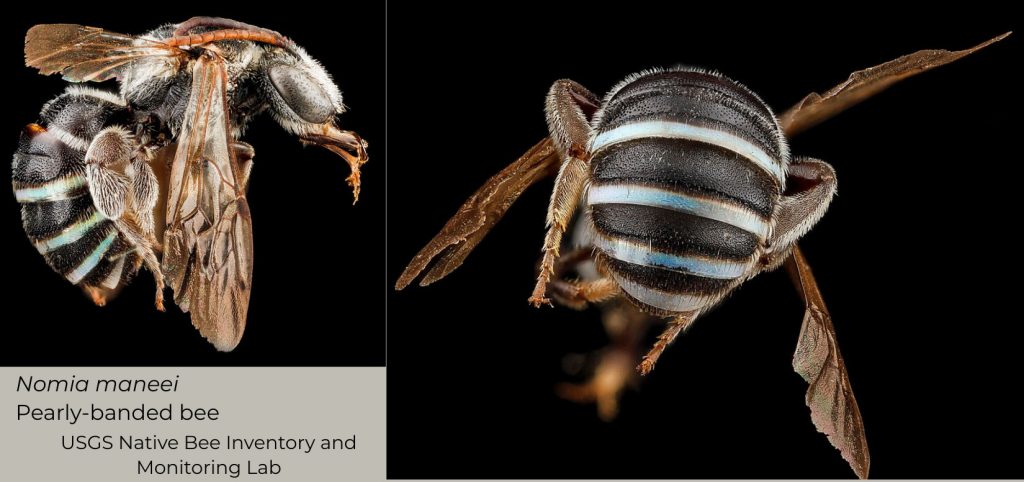By Katy Gorsuch, Education Specialist
It’s Sweat Bee Summer!
We’ve covered sweat bees in a previous edition, but with the temperature rising, the temptation to return to our favorite iridescent insect is undeniable (don’t tell the other bugs!)
As the name suggests, sweat bees are sometimes found collecting sweat from humans. The purpose of such an unusual move is to collect salts, which are often difficult to obtain in the environment. Much like a cow or deer may use a salt-lick, these bees will lap up sweat to supplement their vegetarian diet. The family of bees that are collectively known as sweat bees has some 4.5 thousand species and is called “Halictidae,” giving the group the nickname “Halictid” bees. There is some controversy over the origin of the family name, which may come from the Greek halizein meaning “to gather” or halēs meaning “assembled.” Let’s further muddy the waters by noting that the word “halite,” the mineral from which table salt is taken, comes from the Greek for háls for “salt,” and suggesting another candidate for the origin of the name.
Halictidae is the second largest family of bees in the world, only beaten by the Apidae family, which comprises some 5700 species, including bumblebees and honeybees. Maryland is home to about 120 species of bees in the Halictidae family! Our Maryland sweat bees are classified into nine different genera, of which most belong to the Lasioglossum genus.
Individual species can be difficult to differentiate, and many of Maryland’s sweat bees have no common names (only scientific ones) so we’ll be discussing sweat bees more generally.
A Shining Example
One of the most visible characteristics of many sweat bees is their vibrant green or blue metallic appearance. The genuses Augochloroposis, Augochlorella, and Augochlora all take their names from the Greek words for “to shine” and “green.” Along with Agapostemon, these genera consist only of metallic species in Maryland.
Not all sweat bees are metallic green and blue, although these are certainly noticeable. Maryland species of Sphecodes are red and black, giving rise to their nickname “blood bees,” although intensive interrogation of our state entomologist has led to the reluctant conclusion that none of them are vampires. Dieunomia has no metallic species in Maryland, and while Nomia maneei (the pearly-banded bee) wouldn’t be called metallic, it does possess a rare and beautiful coloration. Not many bees can pull off opalescent banding, but this bee does it with panache!
The Lasioglossum genus is widely varied — some members look more like what we may consider “normal” for a bee, while others do display the green or blue colors we associate with sweat bees. In between are a chorus of variable blacks, deep blues, and even reds that are difficult to appreciate without the help of a microscope!
Don’t Sweat the Small Stuff
Many sweat bees are much smaller than their more well-known cousins — the Gotham bee (Lasioglossum gotham) is about the size of a grain of rice, with the males being even smaller! Being tiny has the advantage of being less noticeable to predators, but means that such tiny bees may easily be overlooked by humans as well: the Gotham bee was only discovered in 2010, despite being common in New York City! The bee, along with ten other sweat bee species, were discovered as part of a survey of the city’s bee populations for the American Museum of Natural History.
One recent study into the species Halictus ligatus found that their size varied significantly across different environments in three different cities: Chicago, St. Louis, and Detroit. Temperature seemed to play a significant role in their sizes, although it was not the only factor. The findings carry weight for the future of native bees in North America and how they may adapt to the rising temperatures caused by climate change.
Bee-havior
When we think of bees, images of hives and queens immediately come to mind. However, the vast majority of native bees are actually solitary. Sweat bees exist in a kind of in-between space; some members are solitary, while others are what is known as “primitively eusocial.” Eusociality is animal social behavior in which a group of adults lives together, cooperatively caring for their young. Additionally, eusocial groups display overlapping generations, and within the group there is a division of labor based on reproduction (think of the queen and workers in a typical honey bee hive). “Primitive” eusociality means that there is not much difference physically between those that reproduce and those who do not, and that the colonies tend to be small and brief, unlike more established eusocial species who may maintain an ongoing colony in the thousands for decades (one hive in Scotland may have been occupied for hundreds of years). For comparison, an L. zephryus nest typically has less than 20 bees living in it.
Besides the sweat bees that are primitively eusocial, others are communal, solitary, and still others are parasitic. The fact that so much diversity exists within the sweat bee family has led experts to look intensely at the group as a model to understand the evolution of social behavior in bees as a whole!
Blood bees (Sphecodes) are known to participate in kleptoparasitism, or food stealing. This is a common tactic across the animal kingdom, and many animals will steal food from others as the opportunity arises. Blood bees have acquired the additional nickname of “cuckoo bees” due to their specific tactic; they will find already laid bee nests and lay their own eggs inside, just like cuckoo birds do with other bird species. Blood bees are not the only cuckoo bees, and this tactic extends to some species of wasp, butterflies, and fish as well as other birds. Blood bees are most likely to seek other sweat bees as the host for their eggs.
Despite all this, adult sweat bees have a varied diet of many native flowers regardless of their social adaptations. Due to being generalists, they visit multiple types of flowers to gather nectar and pollen, acting as diverse and wide-ranging pollinators as a result. When they land to collect salt from humans or other sweaty animals, they do not bite or sting in order to get the minerals they’re seeking, but gently lap it up. Sweat bees are unlikely to sting, and no more dangerous than any other bee to those of us without a bee sting allergy. This summer, if a sweat bee graces you with their presence, take an opportunity to observe this unusual and fascinating bee family up close. To further support them, plant native wildflowers in pots, or in the ground, on your porch or in your yard, and avoid pesticides that often poison species other than the ones they intend to target. No matter your space, small or large, your help makes a difference in the lives of our small buzzing buddies!
Read more about Maryland’s native bees here:
Sweat Bees– Chesapeake Bay Program




